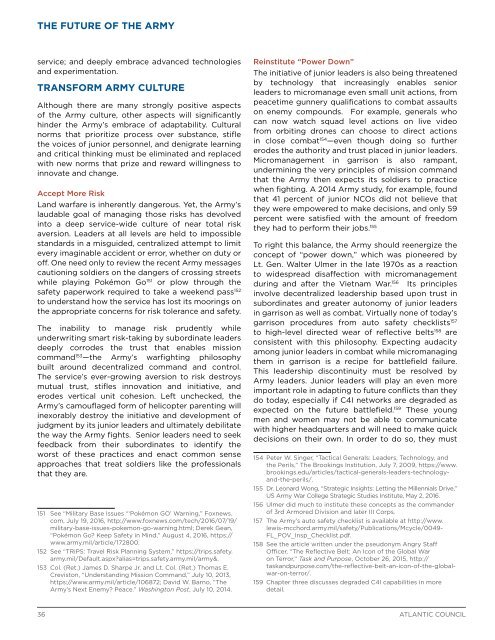FUTURE ARMY
Future_of_the_Army_web_0921
Future_of_the_Army_web_0921
Create successful ePaper yourself
Turn your PDF publications into a flip-book with our unique Google optimized e-Paper software.
THE <strong>FUTURE</strong> OF THE <strong>ARMY</strong><br />
service; and deeply embrace advanced technologies<br />
and experimentation.<br />
TRANSFORM <strong>ARMY</strong> CULTURE<br />
Although there are many strongly positive aspects<br />
of the Army culture, other aspects will significantly<br />
hinder the Army’s embrace of adaptability. Cultural<br />
norms that prioritize process over substance, stifle<br />
the voices of junior personnel, and denigrate learning<br />
and critical thinking must be eliminated and replaced<br />
with new norms that prize and reward willingness to<br />
innovate and change.<br />
Accept More Risk<br />
Land warfare is inherently dangerous. Yet, the Army’s<br />
laudable goal of managing those risks has devolved<br />
into a deep service-wide culture of near total risk<br />
aversion. Leaders at all levels are held to impossible<br />
standards in a misguided, centralized attempt to limit<br />
every imaginable accident or error, whether on duty or<br />
off. One need only to review the recent Army messages<br />
cautioning soldiers on the dangers of crossing streets<br />
while playing Pokémon Go 151 or plow through the<br />
safety paperwork required to take a weekend pass 152<br />
to understand how the service has lost its moorings on<br />
the appropriate concerns for risk tolerance and safety.<br />
The inability to manage risk prudently while<br />
underwriting smart risk-taking by subordinate leaders<br />
deeply corrodes the trust that enables mission<br />
command 153 —the Army’s warfighting philosophy<br />
built around decentralized command and control.<br />
The service’s ever-growing aversion to risk destroys<br />
mutual trust, stifles innovation and initiative, and<br />
erodes vertical unit cohesion. Left unchecked, the<br />
Army’s camouflaged form of helicopter parenting will<br />
inexorably destroy the initiative and development of<br />
judgment by its junior leaders and ultimately debilitate<br />
the way the Army fights. Senior leaders need to seek<br />
feedback from their subordinates to identify the<br />
worst of these practices and enact common sense<br />
approaches that treat soldiers like the professionals<br />
that they are.<br />
151 See “Military Base Issues “‘Pokémon GO’ Warning,” Foxnews.<br />
com, July 19, 2016, http://www.foxnews.com/tech/2016/07/19/<br />
military-base-issues-pokemon-go-warning.html; Derek Gean,<br />
“Pokémon Go? Keep Safety in Mind,” August 4, 2016, https://<br />
www.army.mil/article/172800.<br />
152 See “TRiPS: Travel Risk Planning System,” https://trips.safety.<br />
army.mil/Default.aspx?alias=trips.safety.army.mil/army&.<br />
153 Col. (Ret.) James D. Sharpe Jr. and Lt. Col. (Ret.) Thomas E.<br />
Creviston, “Understanding Mission Command,” July 10, 2013,<br />
https://www.army.mil/article/106872; David W. Barno, “The<br />
Army’s Next Enemy? Peace.” Washington Post, July 10, 2014.<br />
Reinstitute “Power Down”<br />
The initiative of junior leaders is also being threatened<br />
by technology that increasingly enables senior<br />
leaders to micromanage even small unit actions, from<br />
peacetime gunnery qualifications to combat assaults<br />
on enemy compounds. For example, generals who<br />
can now watch squad level actions on live video<br />
from orbiting drones can choose to direct actions<br />
in close combat 154 —even though doing so further<br />
erodes the authority and trust placed in junior leaders.<br />
Micromanagement in garrison is also rampant,<br />
undermining the very principles of mission command<br />
that the Army then expects its soldiers to practice<br />
when fighting. A 2014 Army study, for example, found<br />
that 41 percent of junior NCOs did not believe that<br />
they were empowered to make decisions, and only 59<br />
percent were satisfied with the amount of freedom<br />
they had to perform their jobs. 155<br />
To right this balance, the Army should reenergize the<br />
concept of “power down,” which was pioneered by<br />
Lt. Gen. Walter Ulmer in the late 1970s as a reaction<br />
to widespread disaffection with micromanagement<br />
during and after the Vietnam War. 156 Its principles<br />
involve decentralized leadership based upon trust in<br />
subordinates and greater autonomy of junior leaders<br />
in garrison as well as combat. Virtually none of today’s<br />
garrison procedures from auto safety checklists 157<br />
to high-level directed wear of reflective belts 158 are<br />
consistent with this philosophy. Expecting audacity<br />
among junior leaders in combat while micromanaging<br />
them in garrison is a recipe for battlefield failure.<br />
This leadership discontinuity must be resolved by<br />
Army leaders. Junior leaders will play an even more<br />
important role in adapting to future conflicts than they<br />
do today, especially if C4I networks are degraded as<br />
expected on the future battlefield. 159 These young<br />
men and women may not be able to communicate<br />
with higher headquarters and will need to make quick<br />
decisions on their own. In order to do so, they must<br />
154 Peter W. Singer, “Tactical Generals: Leaders, Technology, and<br />
the Perils,” The Brookings Institution, July 7, 2009, https://www.<br />
brookings.edu/articles/tactical-generals-leaders-technologyand-the-perils/.<br />
155 Dr. Leonard Wong, “Strategic Insights: Letting the Millennials Drive,”<br />
US Army War College Strategic Studies Institute, May 2, 2016.<br />
156 Ulmer did much to institute these concepts as the commander<br />
of 3rd Armored Division and later III Corps.<br />
157 The Army’s auto safety checklist is available at http://www.<br />
lewis-mcchord.army.mil/safety/Publications/Mcycle/0049-<br />
FL_POV_Insp_Checklist.pdf.<br />
158 See the article written under the pseudonym Angry Staff<br />
Officer, “The Reflective Belt: An Icon of the Global War<br />
on Terror,” Task and Purpose, October 26, 2015, http://<br />
taskandpurpose.com/the-reflective-belt-an-icon-of-the-globalwar-on-terror/.<br />
159 Chapter three discusses degraded C4I capabilities in more<br />
detail.<br />
36 ATLANTIC COUNCIL


